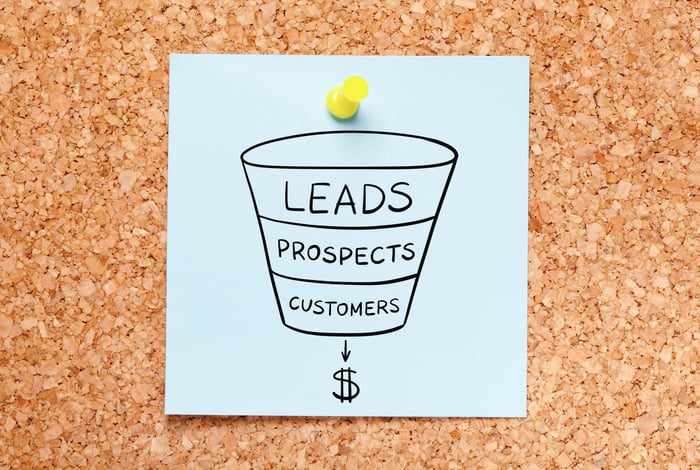
Marketing and the sales funnel go hand in hand. You really can’t have one without the other. We’ll take a deeper dive into the funnel and how to use it for your benefit, but first let's start with an example of how they work together in tandem. Let's imagine a business that sells uniquely appealing and personalized dog collars. The business owner understands that the target demographics for these products include passionate dog owners. These customers are looking for a way to personalize their pets' ID tags, are between the ages of 25 to 65 and spend most of their online time on Facebook.
To attract customers, the company runs a Facebook Ad campaign that helps bring people over to a landing page. The landing page encourages people to submit their email address to sign up on an email list to get a discount on their first collar. At this point, the people in the sales funnel have converted to leads.
Through that email list, the business sends educational content about how to choose the right material for a dog collar, how to choose the right size, and other information, which they may even share with others. After sending this content, people receive a coupon for a percentage off of their first order. Sales increase and the sales funnel is, so far, a proven success.
From there, existing customers are brought over to a new email list and receive different content to direct them toward other products that the company sells, including compatible leashes and dog harnesses, with relevant instructional materials informing customers why they need these products and how to use them. Many of these patrons may be enticed to buy at this point, effectively upselling them and making them repeat clients.
Marketing in the sales funnel like this can significantly boost your advertising efforts, helping you not only get people through the door but keep them there long after that initial sale. According to HubSpot, 65% of businesses state that their biggest marketing challenge is getting traffic and leads. This doesn't have to be the case with a reliable, well-constructed sales funnel in place. In this blog post, we'll review how a sales funnel works and how to appeal to each stage for maximum growth.
What Is the Sales Funnel?
The sales funnel is a series of steps that people go through as they transition from prospects to customers. The sales funnel consists of three core sections, including the top of the funnel (TOFU), the middle of the funnel (MOFU), and the bottom of the funnel (BOFU). At the top, consumers are hooked into the sales funnel by an ad, landing page, or a combination of the two, based on their interests. As they encounter more marketing materials and promotions, they will likely move to the middle of the funnel, eventually winding up as customers at the bottom of the funnel.
There are four stages involved in the sales funnel to keep in mind. They include:
Awareness
The awareness stage is when you would gain the attention of consumers, which you might achieve through an ad, a social media post, an organic search result in Google, or another channel. For example, the Facebook ad used in the above dog collar campaign would serve as the first step in the awareness stage.
When creating your ads and posts, a compelling headline is one of the most important aspects on which to focus and can be a key indicator of success. Ninety percent of people who visit your site because of the headline they saw in an advertisement (or social media post) will go on to read the CTA (call-to-action).
Interest
During the interest stage, consumers will be engaged in more research and start looking for specific solutions to their problems. Content at this point would be educational and inform the audience instead of selling to them. Those dog collar leads would be receiving emails with informational content at this phase.
Keep in mind that content relevancy is crucial at this time—marketers experience a 72% increase in conversion rates when they push relevant content.
Desire
The desire or decision stage is when people are ready to find the right company to satisfy their wishes. They know what they want and are seeking to settle on the ideal provider, so you'll want to encourage them to turn to you at this point. The dog collar distributor at this phase would send out a coupon code for a discount that makes them more affordable than other options.
If you can show why people should buy from you over competitors, you'll be able to attract more customers.
Action
If the awareness, interest, and desire phases are effective, consumers will ideally move into the action stage where they would perform an action like making a purchase from your business or contacting you for a consultation. From the above example, people would be in the process of buying those dog collars by now.
Your work is far from over during the action stage. Instead, add those existing customers to a new segmented list and try to keep them coming back with new and exciting offers. Doing so will help you achieve the maximum customer lifetime value (CLV) through increased retention.
Who Can Be Found in Each Stage?
Throughout the sales funnel, people at the various stages will have different needs.
At the top of the funnel during the awareness stage, you'll want to attract people who are interested in what you offer, though they may not be interested in making a purchase at that time. They might be researching a particular problem that they're facing as they begin to look for a solution to resolve it.
As people continue moving through the sales funnel into the interest stage, they're looking for more information to help them make a buying decision, though they aren't likely ready to buy just yet. They're interested in what you're offering but still need some convincing.
People who move to the bottom of the funnel during the desire and action stages will be ready to make a decision, with their eye on certain benefits and advantages of turning to one provider over another. Here you will really need to sell consumers on why you're the best choice for them.
Marketing to Each Stage
Buyers at different stages of the sales funnel will have different needs, which you will need to fulfill through appropriate marketing tactics.
Attract Attention
To hook those at the top of the funnel, you will need to do what you can to effectively get their attention. This is where you pull them in through various ads and supplemental educational content.
Depending on your audience, you might push social media ads or develop video by working with a media company. You can also develop informational content around many topics that people would be likely to search for on Google.
Use Engaging Landing Pages
From your ads, people will need to be drawn toward high-quality landing pages that help move them along the funnel. Your landing pages should include offers that they won't want to miss. Try your best to convert prospects to leads with these pages. For example, encourage them to subscribe to an email list in exchange for a free ebook or another helpful resource.
Connect with Your Leads with an Email Drip Campaign
Continue to stay in touch with your leads through an email drip campaign whose aim is to push tailored content that provides additional information while convincing them that you're the best resource for their problems. At the very end of the campaign, make an offer they can't refuse, such as a discount, BOGO or another compelling offer that encourages them to go from leads to customers.
After making that first sale, continue to reach out to them with future offers and appreciation emails that help ensure that customers come back to you.
How Utilizing a Sales Funnel Can Help Grow Your Business
Understanding the sales funnel and using it to your advantage will help you attract more high-quality prospects that are more likely to convert into leads and, finally, long-term customers. It's important to go through each stage and figure out how best to connect with each person traveling through the funnel. This will help you create winning marketing materials that increase conversions and sales.
For example, if you have analyzed your audience and know where they spend their time, you can figure out which channels are best to place ads and other marketing efforts during the awareness stage. Social media is one of the best places to connect with audiences without spending too much time. Sixty-six percent of marketers found that spending only six hours every week on social media marketing was sufficient in generating leads.
Once you've led people from that awareness stage down toward the interest and desire stages, you can effectively gain their trust and lead them to make that initial purchase. The key will be a strong content marketing strategy.
In the end, you'll be able to significantly boost ROI and maximize sales while keeping the marketing process more efficient. Through the use of a reliable sales funnel, you'll have a better understanding of your audience and how best to market to them at every stage of the buyer's journey.







